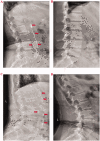Relationship between serum parathyroid hormone levels and abdominal aortic calcification in patients starting hemodialysis who have never taken calcium tablets, calcitriol, or vitamin D analogs
- PMID: 36000910
- PMCID: PMC9415453
- DOI: 10.1080/0886022X.2022.2114369
Relationship between serum parathyroid hormone levels and abdominal aortic calcification in patients starting hemodialysis who have never taken calcium tablets, calcitriol, or vitamin D analogs
Abstract
Background: Vascular calcification (VC) and secondary hyperparathyroidism (SHPT) are important causes of the high incidence of cardiovascular events in chronic kidney disease (CKD) patients. The relationship between parathyroid hormone (PTH) and VC is very complex. The aim of this study was to determine the correlation between PTH levels and abdominal aortic calcification (AAC) in patients starting hemodialysis who had not received calcium tablets, calcium-containing phosphorus binders, calcitriol, or vitamin D analogs.
Methods: Seventy-one patients were included. Latero-lateral X-ray lumbar radiography, serum intact PTH (iPTH) levels, and predialysis biochemical parameters were obtained. The degree of AAC was evaluated according to the methods described previously by Kauppila et al.
Results: We found that there was a strong negative correlation between serum PTH and AAC (Spearman's rho -0.76, p < 0.001). Receiver operating characteristic (ROC) curve analysis showed that low serum PTH level could predict the presence and extent of AAC (area under the curve values were 0.9013 [p < 0.0001] and 0.780 [p = 0.0041], respectively).
Conclusions: Our results indicate that serum PTH level is significantly negatively correlated with AAC within a certain concentration range in patients starting hemodialysis who had not received calcium tablets, calcium-containing phosphorus binders, calcitriol, or vitamin D analogs.
Keywords: Chronic kidney disease; abdominal aortic calcification; parathyroid hormone; vascular calcification.
Conflict of interest statement
No potential conflict of interest was reported by the author(s).
Figures



Similar articles
-
1alpha(OH)D3 One-alpha-hydroxy-cholecalciferol--an active vitamin D analog. Clinical studies on prophylaxis and treatment of secondary hyperparathyroidism in uremic patients on chronic dialysis.Dan Med Bull. 2008 Nov;55(4):186-210. Dan Med Bull. 2008. PMID: 19232159 Review.
-
[Changes in mineral metabolism in stage 3, 4, and 5 chronic kidney disease (not on dialysis)].Nefrologia. 2008;28 Suppl 3:67-78. Nefrologia. 2008. PMID: 19018742 Spanish.
-
Progression of Vascular Calcification and Clinical Outcomes in Patients Receiving Maintenance Dialysis.JAMA Netw Open. 2023 May 1;6(5):e2310909. doi: 10.1001/jamanetworkopen.2023.10909. JAMA Netw Open. 2023. PMID: 37126347 Free PMC article.
-
Control of parathyroid function in patients with a short history of hemodialysis.Ther Apher Dial. 2005 Feb;9(1):39-43. doi: 10.1111/j.1774-9987.2005.00212.x. Ther Apher Dial. 2005. PMID: 15828904 Clinical Trial.
-
Vitamin D analogues for the management of secondary hyperparathyroidism.Am J Kidney Dis. 2001 Nov;38(5 Suppl 5):S34-40. doi: 10.1053/ajkd.2001.28109. Am J Kidney Dis. 2001. PMID: 11689385 Review.
Cited by
-
Causal factors of cardiovascular disease in end-stage renal disease with maintenance hemodialysis: a longitudinal and Mendelian randomization study.Front Cardiovasc Med. 2024 Jul 18;11:1306159. doi: 10.3389/fcvm.2024.1306159. eCollection 2024. Front Cardiovasc Med. 2024. PMID: 39091361 Free PMC article.
References
-
- Foley RN, Parfrey PS, Sarnak MJ.. Clinical epidemiology of cardiovascular disease in chronic renal disease. Am J Kidney Dis. 1998;32(5):S112–S119. - PubMed
-
- Mizobuchi M, Towler D, Slatopolsky E.. Vascular calcification: the killer of patients with chronic kidney disease. J Am Soc Nephrol. 2009;20(7):1453–1464. - PubMed
-
- London GM, Guérin AP, Marchais SJ, et al. . Arterial media calcification in end-stage renal disease: impact on all-cause and cardiovascular mortality. Nephrol Dial Transplant. 2003;18(9):1731–1740. - PubMed
MeSH terms
Substances
LinkOut - more resources
Full Text Sources
